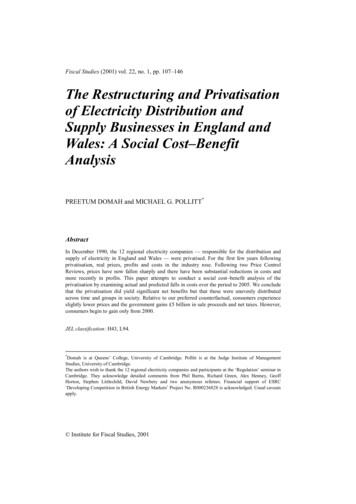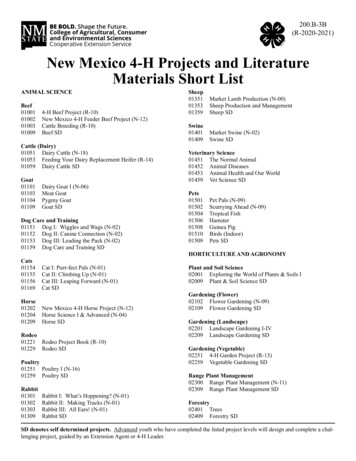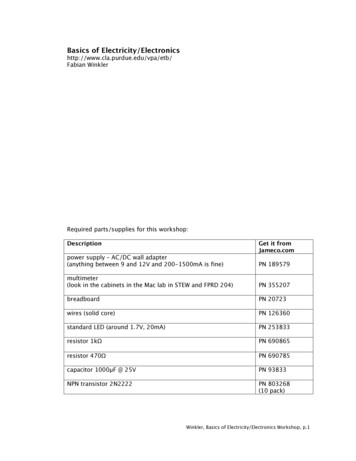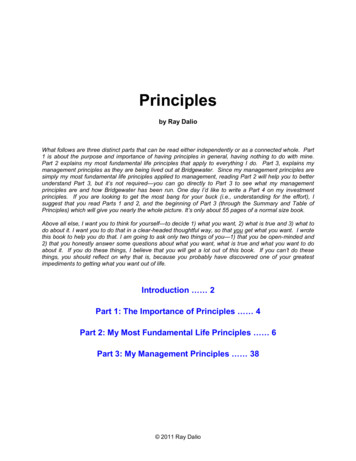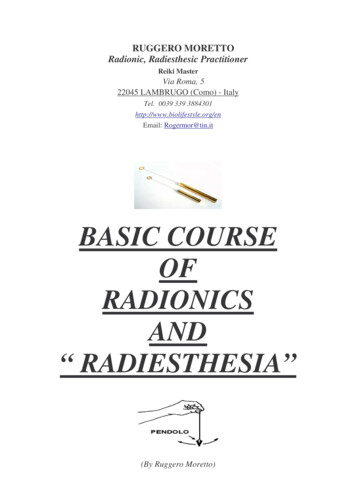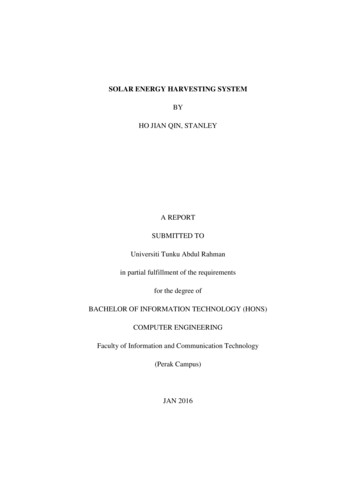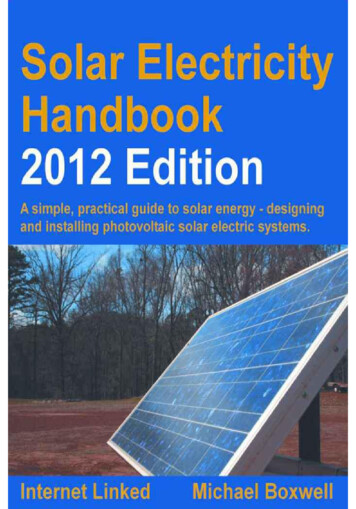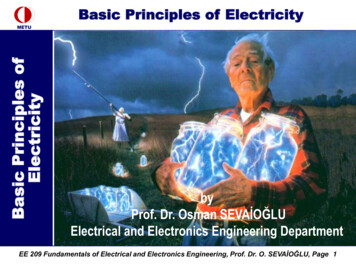
Transcription
Basic Principles of ElectricityBasic Principles ofElectricityMETUbyProf. Dr. Osman SEVAİOĞLUElectrical and Electronics Engineering DepartmentEE 209 Fundamentals of Electrical and Electronics Engineering, Prof. Dr. O. SEVAİOĞLU, Page 1
Basic Principles of ElectricityMETUCourse SyllabusEE 209Fundamentals of Electrical and ElectronicsEngineering (3-0)3 Basic Principles of Electricity, Circuit Analysis,AC Circuits,AC Power,Phasors,Three Phase Systems,Transformers,Magnetic Circuits,Electrical Safety(Offered to non-EE students only)Prerequisite: PHYS 106 or consent of the department.EE 209 Fundamentals of Electrical and Electronics Engineering, Prof. Dr. O. SEVAİOĞLU, Page 2
Basic Principles of ElectricityMETUBook for the CourseEE 209 Fundamentals of Electrical and Electronics Engineering, Prof. Dr. O. SEVAİOĞLU, Page 3
Basic Principles of ElectricityMETUBook for the CoursePrinciples and Applications ofElectrical Engineering, 4/eGiorgio RizzoniThe Ohio State UniversityMc. Graw Hill Book Company,ISBN: 0072463473Copyright year: 2003999 PagesAvailable in Reserve Division of theMiddle East Technical UniversityCentral LibraryEE 209 Fundamentals of Electrical and Electronics Engineering, Prof. Dr. O. SEVAİOĞLU, Page 4
Basic Principles of ElectricityMETUCourse SyllabusChapters to be Covered Basic Principles of Electricity,Circuit Analysis,AC Circuits,AC Power,Phasors,Three Phase Systems,Transformers,Magnetic Circuits,Electrical SafetyEE 209 Fundamentals of Electrical and Electronics Engineering, Prof. Dr. O. SEVAİOĞLU, Page 5
Basic Principles of ElectricityMETUBasic Principles of the CourseExaminationsTwo midterm examinations and a final examMidterm Exam 1 (Three questions, equal credits, 90 min)Midterm Exam 2 (Three questions, equal credits, 90 min)Final Exam(Four questions, equal credits, 120 min)Attendance20203030%%%% ------------Total100 %EE 209 Fundamentals of Electrical and Electronics Engineering, Prof. Dr. O. SEVAİOĞLU, Page 6
Basic Principles of ElectricityMETUHomeworkNo homeworks will be assignedYou are advise to examine; the homeworks in the book, examination questions that will be distributedEE 209 Fundamentals of Electrical and Electronics Engineering, Prof. Dr. O. SEVAİOĞLU, Page 7
Basic Principles of ElectricityMETUBasic Principles of the CourseExaminations Midterm examinations will cover all the material taught until theexamination date,Final Examination will cover the overall course material,Announced exam schedule can neither be changed nor discussedafter it has been settled,Duration of the examination will never be extended,Questions will never be allowed during the examinationEE 209 Fundamentals of Electrical and Electronics Engineering, Prof. Dr. O. SEVAİOĞLU, Page 8
Basic Principles of ElectricityMETUBasic Principles of the CourseMake-up Examinations Will be given only to those students with valid documented excuse,Requests for make-up exam that does not include a valid documentedexcuse will be rejected,A single make-up exam will be given to all students with legitimaterights for the exam,Exam will be carried out in an officially settled date and hour,Exam will not be repeated, i.e. Make-up of make-up will not beperformed,Students will be responsible for answering the questions only from theparts covered in the exam that they have missedEE 209 Fundamentals of Electrical and Electronics Engineering, Prof. Dr. O. SEVAİOĞLU, Page 9
Basic Principles of ElectricityMETUQuestions and Solutions of the Previous ExaminationsExam Questionsand Solutions A file including all exam questions andsolutions is available, A file including the questions andsolutions of all the previousexaminations will be submitted to astudent who is elected by the class forphotocopying and distributing this fileto the class, This student will be responsible for thetoll collection and distribution activityIn case that there is no valunteer for thejob, the task will be cancelled !EE 209 Fundamentals of Electrical and Electronics Engineering, Prof. Dr. O. SEVAİOĞLU, Page 10
Basic Principles of ElectricityMETUYahoo Group for the Coursehttp://groups.yahoo.com/group/ee209/Yahoo Group for the course is;http://groups.yahoo.com/group/ee209/This group is intended to be the main communication medium forinformation exchange and storage for the courseEnrollment to this group is compulsory --All students are obliged to subscribe to this group by using theprocedure described in the next pageEE 209 Fundamentals of Electrical and Electronics Engineering, Prof. Dr. O. SEVAİOĞLU, Page 11
Basic Principles of ElectricityMETUE-mail GroupEnrollmentTo subscribe from the group, send an email to:ee209-subscribe@yahoogroups.comTo unsubscribe from the group, send an email to:ee209-unsubscribe@yahoogroups.comEE 209 Fundamentals of Electrical and Electronics Engineering, Prof. Dr. O. SEVAİOĞLU, Page 12
Basic Principles of ElectricityMETUE-mail GroupNicknames (User Ccodes)NicknamesPlease choose nicknames that reflect your personal identity, i.e. yoursurname and/or name and/or you name and surname augmented.Please do NOT choose improper or annoying nicknames, such as;“Arizona Tigers”, “diabolic, “best friend”, “miserable(68)” etc. thatdoes not reflect your personal identityEE 209 Fundamentals of Electrical and Electronics Engineering, Prof. Dr. O. SEVAİOĞLU, Page 13
Basic Principles of ElectricityMETUE-mail GroupCommunicationAll questions, suggestions, complaints, demands, requests and othercommunication concerning the course should be directed to the e-mailcommunication address of the group:ee209@yahoogroups.comThe Course Instructor keeps the right of not answering some or allof the questions, suggestions, complaints, demands, requestsforwarded in this mail group, in case that it is not necessary, or notrelevant, or not possibleEE 209 Fundamentals of Electrical and Electronics Engineering, Prof. Dr. O. SEVAİOĞLU, Page 14
Basic Principles of ElectricityMETUE-mail GroupRules of CommunicationIn your e-mails; Be polite, Start your letter with; “Dear Group Members” or “Dear Friends”and end with; “With best regards” Do not use disturbing abbreviatons, such as “slm” for “selam”, Do not discuss your own personal, social or academic problems, Do not be aggressive to the Group members and to CourseInstructor, Do not discuss subjects not relevant to the course, (such aslast match of Fenerbahçe)People who violate the above rules will be deleted from the groupEE 209 Fundamentals of Electrical and Electronics Engineering, Prof. Dr. O. SEVAİOĞLU, Page 15
Basic Principles of ElectricityMETUE-mail GroupGroup ModeratorsCourse Instructor is the Main Moderator of the e-mail Group.Assistant ModeratorAn assistant moderator who is familiar with the management ofyahoogroups activities, will be elected and appointed for managingthe group from valunteer candidates in the class during the first hour.Moderators have identical authorities in group management in allrespectsEE 209 Fundamentals of Electrical and Electronics Engineering, Prof. Dr. O. SEVAİOĞLU, Page 16
Basic Principles of ElectricityMETUProblemsComplaints and ExpressionsComplaints and expressions concerning your; personal, Social, Academicproblems will never be listened, nor be appreciated nor be interested. Your personal, social and academic problems will never be aninfluencing factor in grading, Your personal, social and academic problems will not be taken into accountat allThis course is NOT a proper platform for expressing your own problems,negative or positive human feelings, such as, crying, complaining,hating, admiring, or any other physiologic, psychological expressionsEE 209 Fundamentals of Electrical and Electronics Engineering, Prof. Dr. O. SEVAİOĞLU, Page 17
Basic Principles of ElectricityMETUE-mail GroupOffice HoursUnfortunately, there will not be any chance for office hour Please do not refer my office for any reason, and do not blame for that.EE 209 Fundamentals of Electrical and Electronics Engineering, Prof. Dr. O. SEVAİOĞLU, Page 18
Basic Principles of ElectricityMETUE-mail GroupTelephone CallsMy GSM No: 0 532 384 78 65Telephone calls for concerning your personal, social and academicproblems will neither be listened, nor be appreciated nor be interestedEE 209 Fundamentals of Electrical and Electronics Engineering, Prof. Dr. O. SEVAİOĞLU, Page 19
Basic Principles of ElectricityMETUE-mail GroupWeekly Course Schedule (Three hours/week)Announced schedule can be discussedEE 209 Fundamentals of Electrical and Electronics Engineering, Prof. Dr. O. SEVAİOĞLU, Page 20
Basic Principles of ElectricityMETUAtomStructure of atomElectron is assumed to be negatively chargedProton is assumed to be positive chargedHelium AtomElectronProtonNeutronEE 209 Fundamentals of Electrical and Electronics Engineering, Prof. Dr. O. SEVAİOĞLU, Page 21
Basic Principles of ElectricityMETUElectrical ChargeDefinitionUnit of Electrical Charge Coulomb 186.3 x 10 electrons 1 CoulomborElectrical charge / electron 1/ (6.3 x 1018)Coulomb 1.602 x 10-19 CoulombEE 209 Fundamentals of Electrical and Electronics Engineering, Prof. Dr. O. SEVAİOĞLU, Page 22
Basic Principles of ElectricityMETUBasic Principle of CircuitMechanical ExampleInclined Surfaceh2 hh1EE 209 Fundamentals of Electrical and Electronics Engineering, Prof. Dr. O. SEVAİOĞLU, Page 23
Basic Principles of ElectricityMETUWater CircuitWater Current (I)PumpWater Current Volume (m3) / secEE 209 Fundamentals of Electrical and Electronics Engineering, Prof. Dr. O. SEVAİOĞLU, Page 24
Basic Principles of ElectricityMETUWater CircuitWater Current (I)P2P1PumpGravitational force P P2 - P1EE 209 Fundamentals of Electrical and Electronics Engineering, Prof. Dr. O. SEVAİOĞLU, Page 25
Basic Principles of ElectricityMETUElectrical CircuitElectromotive forceElectrical Current (I)Consumer(Load)Electrical Current No. of electrons / sec 1 Coulomb / sec186.3 x 10 electrons / sec 1 AmperEE 209 Fundamentals of Electrical and Electronics Engineering, Prof. Dr. O. SEVAİOĞLU, Page 26
Basic Principles of ElectricityMETUElectrical CircuitElectrical Current (I)Voltage (V)Electromotive forceCurrent (I) Consumer(Load)EE 209 Fundamentals of Electrical and Electronics Engineering, Prof. Dr. O. SEVAİOĞLU, Page 27
Basic Principles of ElectricityMETUVoltage DifferencePressure DifferenceVoltage DifferenceCurrent (I)P2P1PumpGravitational force P P2 - P1V2 V V2 - V1 V1EE 209 Fundamentals of Electrical and Electronics Engineering, Prof. Dr. O. SEVAİOĞLU, Page 28
Basic Principles of ElectricityMETUGround Node (Earth Point)DefinitionCurrent (I)Ground Node is the point(junction) at which the voltage isassumed to be zeroAll other voltages takes theirreferences with respect to thisground nodeRepresentationV2 V V2 - V1 V2Ground NodeV1V1 0EE 209 Fundamentals of Electrical and Electronics Engineering, Prof. Dr. O. SEVAİOĞLU, Page 29
Basic Principles of ElectricityMETUGround Node (Earth Point)DefinitionGround Node is the point (junction) at which thevoltage is assumed to be zeroAll other voltages takes their references withrespect to this ground nodeGround Node(Black Terminal )Measured Node(Red Terminal )EE 209 Fundamentals of Electrical and Electronics Engineering, Prof. Dr. O. SEVAİOĞLU, Page 30
Basic Principles of ElectricityMETUElectrical CurrentCurrent no. of electrons transferred / time durationI Q / t1 Amp 1 Coulomb / 1 SecondsCharge Current x Time duration Q I x tCurrent(I)Voltage difference( V) Current(I)Consumer(Load)EE 209 Fundamentals of Electrical and Electronics Engineering, Prof. Dr. O. SEVAİOĞLU, Page 31
Basic Principles of ElectricityMETUTraffic CurrentCars Flowing in a HighwayTraffic Current Cars / minuteEE 209 Fundamentals of Electrical and Electronics Engineering, Prof. Dr. O. SEVAİOĞLU, Page 32
Basic Principles of ElectricityMETUWater CurrentBirecik Dam (672 MW)Water Current 500 m3 / secWater Current Volume (m3) / secEE 209 Fundamentals of Electrical and Electronics Engineering, Prof. Dr. O. SEVAİOĞLU, Page 33
Basic Principles of ElectricityMETU1 meterExample: Electrical Current2 mm diameterEE 209 Fundamentals of Electrical and Electronics Engineering, Prof. Dr. O. SEVAİOĞLU, Page 34
Basic Principles of ElectricityMETU1 meterExample: Electrical Current2 mm diameterEE 209 Fundamentals of Electrical and Electronics Engineering, Prof. Dr. O. SEVAİOĞLU, Page 35
Basic Principles of ElectricityMETU1 meterElectrical Current2 mm diameterEE 209 Fundamentals of Electrical and Electronics Engineering, Prof. Dr. O. SEVAİOĞLU, Page 36
Basic Principles of ElectricityMETUElectrical Current - Basic PrincipleElectronsCurrentElectromotive forceV2 V V2 - V1ElectronsV1EE 209 Fundamentals of Electrical and Electronics Engineering, Prof. Dr. O. SEVAİOĞLU, Page 37
Basic Principles of ElectricityMETUElectrical CurrentDC (Direct Current) SourcesV2V2 V V2 - V1V1 V V2 - V1V1 0EE 209 Fundamentals of Electrical and Electronics Engineering, Prof. Dr. O. SEVAİOĞLU, Page 38
Basic Principles of ElectricityMETUSimple AC CircuitCurrent(I)GeneratorCustomerEE 209 Fundamentals of Electrical and Electronics Engineering, Prof. Dr. O. SEVAİOĞLU, Page 39
Basic Principles of ElectricityMETUKirchoff’s Current Law (KCL)Basic Principle Cars entering Cars leavingBalanceCars entering:Cars leaving:3701206555130 ----------370EE 209 Fundamentals of Electrical and Electronics Engineering, Prof. Dr. O. SEVAİOĞLU, Page 40
Basic Principles of ElectricityMETUKirchoff’s Current Law (KCL)Charges enteringQ1Q2Qn-1 -----------QinCharges leavingQout QnBalanceQin QoutorQin – Qout 0 or Q 0EE 209 Fundamentals of Electrical and Electronics Engineering, Prof. Dr. O. SEVAİOĞLU, Page 41
Basic Principles of ElectricityMETUKirchoff’s Current Law (KCL)or Q 0 Qn Coulombs/secor Q / t 0ori n Ii 0i 1Kirchoff’s First LaworKirchoffs Current LawEE 209 Fundamentals of Electrical and Electronics Engineering, Prof. Dr. O. SEVAİOĞLU, Page 42
Basic Principles of ElectricityMETUMechanical ForceDefinitionF mxaForce needed to accelarate 1 kg of mass to 1 meter / sec2is defined as 1 Newton1 Newton 1 kg x 1 meter / sec21000 Newton 1000 kg x 1 meter / sec2Accelaration 1 m/sec2WagonMass 1000 kgForce 1000 NewtonEE 209 Fundamentals of Electrical and Electronics Engineering, Prof. Dr. O. SEVAİOĞLU, Page 43
Basic Principles of ElectricityMETUMechanical EnergyDefinition1 Joule 1 Newton x 1 Meter1 Joule is the energy needed to move amass 1 meter by using 1 Newton force1 MeterWagon1 NewtonWagonEE 209 Fundamentals of Electrical and Electronics Engineering, Prof. Dr. O. SEVAİOĞLU, Page 44
Basic Principles of ElectricityMETUPowerDefinitionPower is the work done within a certainunit of time, i.e. one second or one hourPower Energy / Duration 1 Joule / secPlease note that force (and hencepower) of the weak horse shownbelow is half of the first, but thework done (energy spent) is thesame, i.e.Energy 2 seconds x 0.5 Newton x1 meter2 seconds1 sec1 MeterWagon1 Meter1 NewtonWagonEnergy 1 Joule, Power 1 Joule / sec.Wagon0.5 NewtonWagonEnergy 1 Joule, Power 1 Joule / 2 sec.EE 209 Fundamentals of Electrical and Electronics Engineering, Prof. Dr. O. SEVAİOĞLU, Page 45
Basic Principles of ElectricityMETUMechanical Energy vs Electrical EnergyEquivalanceThe same amount of energy maybe spent out by using electricityMechanical Energy Electrical EnergyMechanical Work Electrical Work1 MeterWagon1 NewtonWagonCurrent (I)Voltage(V) 1 JouleMechanical Energy (Work) 1 JouleElectrical Energy (Work) 1 JouleEE 209 Fundamentals of Electrical and Electronics Engineering, Prof. Dr. O. SEVAİOĞLU, Page 46
Basic Principles of ElectricityMETUElectrical PowerDefinitionSimilar to mechanical power, electrical power isthe work done within a certain unit of time, i.e.one second or one hourElecrical Power Electrical Energy / Duration 1 Joule / sec(1 sec)Current (I)1 sec1 Meter1 NewtonVoltage(V)Wagon WagonMechanical Power 1 Joule / sec.Electrical Power 1 Joule / sec.EE 209 Fundamentals of Electrical and Electronics Engineering, Prof. Dr. O. SEVAİOĞLU, Page 47
Basic Principles of ElectricityMETUEquivalence of Mechanical and Electrical PowersEquivalanceMechanical Power Electrical Power(1 sec)Current (I)1 sec1 MeterWagon1 NewtonWagonMechanical Power 1 Joule / sec.Voltage(V) Electrical Power 1 Joule / sec.EE 209 Fundamentals of Electrical and Electronics Engineering, Prof. Dr. O. SEVAİOĞLU, Page 48
Basic Principles of ElectricityMETUElectrical PowerDefinition1 Joule / second 1 Watt(1 Joule energy is spent within 1 second)1 Joule 1 Watt x second1 Horse Power 746 Watts 0.746 kWatt(1 sec)Current (I)1 sec1 MeterWagon1 NewtonWagon1 Joule / sec 1 WattVoltage(V) Electrical Power 1 Joule / sec. 1 WattEE 209 Fundamentals of Electrical and Electronics Engineering, Prof. Dr. O. SEVAİOĞLU, Page 49
Basic Principles of ElectricityMETUElectrical PowerDefinitionP V(Watt) (Volt)Power Voltage x CurrentIx (Amp)xCurrent (Amp)DC Voltage(Volt) Power (Watt)EE 209 Fundamentals of Electrical and Electronics Engineering, Prof. Dr. O. SEVAİOĞLU, Page 50
Basic Principles of ElectricityMETUVoltageDefinitionPower Voltage x CurrentorP VxIVoltage Power / CurrentorV P/ICurrentDCVoltage PowerEE 209 Fundamentals of Electrical and Electronics Engineering, Prof. Dr. O. SEVAİOĞLU, Page 51
Basic Principles of ElectricityMETUVoltageDefinitionCurrent (1 Amp)Power Voltage x CurrentorVoltage Power / CurrentorV P/IDC Voltage(1 Volt) Power(1 Watt)1 Volt 1 Watt / 1 AmpEE 209 Fundamentals of Electrical and Electronics Engineering, Prof. Dr. O. SEVAİOĞLU, Page 52
Basic Principles of ElectricityMETUElectrical EnergyDefinitionEnergy Power x Time(Watt-sec) (Watt) (second)Current (I)DC Voltage(V) Energy Power x TimeEE 209 Fundamentals of Electrical and Electronics Engineering, Prof. Dr. O. SEVAİOĞLU, Page 53
Basic Principles of ElectricityMETUUnit of Electrical EnergyDefinitionEnergy Power(Watt-sec) (Watt)Energy xTime(second)Power(KiloWatt-hour) (KiloWatt)x 10001 KiloWatt 1000 Watts1 Hour 3600 secondsx 1000xCurrent (I)Time(hour)DC Voltage (V)x 36001 KiloWatt - hour 1000 x 3600 Watt x seconds 3 600 000 JoulesEnergy Power x TimeEE 209 Fundamentals of Electrical and Electronics Engineering, Prof. Dr. O. SEVAİOĞLU, Page 54
Basic Principles of ElectricityMETUElectrical EnergyExampleCalculate the monthly payment for the energyconsumed by the lamp shown on the RHSV 220 VSource voltage is 220 VoltCurrent drawn by the lamp is 5 AmpPrice of electrical energy is 12 Cents / kWhPower Voltage x CurrentP V x IP 220 x 5 1100 WattsEnergy P x t 1100 Watts x ( 24 hours /day x 30 days/month) 792000 Watt hours 790.2 kWhMonthly payment 790.2 x 12 Cents / month 90.504 USD 122 .1 YTL / monthI 5 AmpEE 209 Fundamentals of Electrical and Electronics Engineering, Prof. Dr. O. SEVAİOĞLU, Page 55
Basic Principles of ElectricityMETUAlternative Definition of Voltage1 Volt----------------------------(*) 1 Watt / 1 Amp (1 Joule /sec) / 1 Amp 1 Joule / (1 Amp x sec) 1 Joule / 1 Coulomb (*)Remember that 1 Amp 1 Coulomb / 1 sec1 Volt is the voltage needed;1 Coulomb 1 Volt to move 1 Coulomb of electrical charge, to spend 1 Joule of energy for this movementin a conductor1 Joule energyEE 209 Fundamentals of Electrical and Electronics Engineering, Prof. Dr. O. SEVAİOĞLU, Page 56
Basic Principles of ElectricityMETUAlternative Definition of Voltage1 Volt 1 Joule / 1 CoulombPlease note that time parameter does not appear in theabove equation, implying that it is arbitraryCase-1Let t 1 secThen, I 1 Coulomb / 1 sec 1 AmpP V x I 1 Volt x 1 Amp 1 WattEnergy P x t (1 Joule / sec) x sec 1 JouleCase-2Let now t 2 secThen, I 1 Coulomb / 2 sec 0.5 AmpP V x I 1 Volt x 0.5 Amp 0.5 Watt Energy / 2 0.5 Joule / secEnergy P x t 0.5 x 2 1 Joule again1 Coulomb 1 Volt1 Joule energyEE 209 Fundamentals of Electrical and Electronics Engineering, Prof. Dr. O. SEVAİOĞLU, Page 57
Basic Principles of ElectricityMETUResistanceDefinitionResistance R1R1 R2Resistance R2Resistance is thereaction of a pipeagainst water flowPumpCurrent I1I1PumpI2 I 1I2Current I2EE 209 Fundamentals of Electrical and Electronics Engineering, Prof. Dr. O. SEVAİOĞLU, Page 58
Basic Principles of ElectricityMETUResistanceDefinitionResistance is the reaction of aconductor against electrical currentResistance R1Current I1R1 R2Resistance R2Current I1I1 I 2EE 209 Fundamentals of Electrical and Electronics Engineering, Prof. Dr. O. SEVAİOĞLU, Page 59
Basic Principles of ElectricityMETUOhm LawBasic PrinciplesCurrent flowing in the circuit is; proportional to voltage, inversely proportional to resistanceCurrent I (Amp)Voltage(Volt)IHenceUnit of resistance is Ohm1 Ohm is the resistance that allows 1 Amperto pass at 1 Volts voltage;1 Ohm 1 Volt / 1 Amper (Amp)Resistance(R) V/ R(Volt)(Ohm)orV(Volt) R(Ohm)xI(Amp)EE 209 Fundamentals of Electrical and Electronics Engineering, Prof. Dr. O. SEVAİOĞLU, Page 60
Basic Principles of ElectricityMETUOhm LawTwo circuits with different Resistances, identical voltage sourcesR1 R2Resistance R1Resistance R2Current (I1)Voltage(V)Current (I2) Voltage(V)Resistance(R1)V / R1 I1I 1 I2 Resistance(R2)V / R2 I2EE 209 Fundamentals of Electrical and Electronics Engineering, Prof. Dr. O. SEVAİOĞLU, Page 61
Basic Principles of ElectricityMETUOhm LawV-I Characteristics30,0 Resistance(R)Voltage (Volts)Voltage (Volt)Current I (Amp)25,020,015,0Slope V / I R10,0V(Volt) R x I5,0V varies linearly with I(Ohm) (Amp)0,00,05,010,015,020,0Current I (Amp)EE 209 Fundamentals of Electrical and Electronics Engineering, Prof. Dr. O. SEVAİOĞLU, Page 62
Basic Principles of ElectricityMETUOhm Law - ExampleQuestionCalculate the current flowing in thecircuit shown on the RHSV(Volt)ICurrent I (Amp)V 220 V R 5 Ohm Rx I (Ohm) x (Amp) V/R 220 / 5 44 AmpsEE 209 Fundamentals of Electrical and Electronics Engineering, Prof. Dr. O. SEVAİOĞLU, Page 63
Basic Principles of ElectricityMETUOhm LawNonlinear V-I Characteristics R x(Volt)Note that resistance increases with temperature,hence current is reducedI(Ohm) (Amp)R R0 (1 t) t T – 23 0 CR0 Resistance at 23 0 C The temperature coeff. of the metalVoltage (Volts)V250200150100500V 220 VSlope V / I R-50-100-150-200-250I 5 Amp-15-10-5051015Load Current I (Amp)EE 209 Fundamentals of Electrical and Electronics Engineering, Prof. Dr. O. SEVAİOĞLU, Page 64
Basic Principles of ElectricityMETUResistance FormulaResistance FormulaR l /AACSR Conductor(Aluminum Conductor Steel Reinforced)l (meter)A (mm2)where, R is the resistance of conductor, is the resistivity coefficient, 1 / 56 Ohm-mm2/m (Copper)1 / 32 Ohm-mm2/m (Aluminum)l (m) is the length of the conductorA (mm2) is the cross sectional area ofthe conductorEE 209 Fundamentals of Electrical and Electronics Engineering, Prof. Dr. O. SEVAİOĞLU, Page 65
Basic Principles of ElectricityMETUResistance FormulaResistance FormulaResistance of a cable is proportional to thelength and inversely proportional to thecross sectional area of the cableR l /Awhere, R is the resistance of conductor, is the resistivity coefficient, 1 / 56 Ohm-mm2/m (Copper)1 / 32 Ohm-mm2/m (Aluminum)l (m) is the length of the conductorA (mm2) is the cross sectional area ofthe conductorEE 209 Fundamentals of Electrical and Electronics Engineering, Prof. Dr. O. SEVAİOĞLU, Page 66
Basic Principles of ElectricityMETUResistance FormulaResistance FormulaAluminum ConductorsExampleCalculate the resistance of acopper cable with length 3200meters and cross section 240 mm2SolutionR (1 / 56) 3200 / 240 0.238 OhmsEE 209 Fundamentals of Electrical and Electronics Engineering, Prof. Dr. O. SEVAİOĞLU, Page 67
Basic Principles of ElectricityMETUResistance FormulaResistance FormulaExampleCalculate the resistance of a copper cablewith length 3200 meters and cross section240 mm2SolutionR (1 / 56) 3200 / 240 0.238 OhmsACSR Conductor(Aluminum Conductor Steel Reinforced)l 3200 (m)A 240 (mm2)EE 209 Fundamentals of Electrical and Electronics Engineering, Prof. Dr. O. SEVAİOĞLU, Page 68
Basic Principles of ElectricityMETUResistivity Coefficients of Various MetalsFormula 1 / 56 Ohms/meter (Copper)Resistivity CoefficientsMaterial 0.0178571 Ohm-mm2/mR l /Awhere, R is the resistance of conductor, is the resistivity coefficient, 1 / 56 Ohm-mm2/m (Copper)1 / 32 Ohm-mm2/m (Aluminum)l (m) is the length of the conductorA (mm2) is the cross sectional areaof the 000.01270EE 209 Fundamentals of Electrical and Electronics Engineering, Prof. Dr. O. SEVAİOĞLU, Page 69
Basic Principles of ElectricityMETUColor Codes for ResistancesRuleEE 209 Fundamentals of Electrical and Electronics Engineering, Prof. Dr. O. SEVAİOĞLU, Page 70
Basic Principles of ElectricityMETUInsulatorInsulatorHV sideInsulator is a material with almost infiniteresistanceInsulators are used to support HV lines andconductorsIn practice, all materials have resistances.Hence, they conduct a certain amount ofcurrent when a voltage is applied to theterminals.Insulator are materials that conduct only avery small amount of current, even when anextremely high voltage is applied to theterminals.Ground sideEE 209 Fundamentals of Electrical and Electronics Engineering, Prof. Dr. O. SEVAİOĞLU, Page 71
Basic Principles of ElectricityMETUPower dissipation in a ResistanceCurrent, IV R x I(Volt) (Ohm) (Amp)On the other hand, it was shownin this lecture that;Power Voltage x CurrentorP VxI Voltage, VRPowerHence, power dissipation inresistance R isPower R x I x I R x I2 WattEE 209 Fundamentals of Electrical and Electronics Engineering, Prof. Dr. O. SEVAİOĞLU, Page 72
Basic Principles of ElectricityMETUSeries Connected ResistancesEquivalent Resistance FormulaR1 l 1 / A1R2 l 2 / A2Let A1 A2Hence;l total l 1 ll 3200 (m)A 240 (mm2)l 3200 (m)A 240 (mm2)2Rtotal l total / A (l 1 l 2 ) / A l1/A l2/A R1 R2EE 209 Fundamentals of Electrical and Electronics Engineering, Prof. Dr. O. SEVAİOĞLU, Page 73
Basic Principles of ElectricityMETUSeries Connected ResistancesEquivalent Resistance FormulaRtotal R1 R2Series connected resistances are addedR1R2RkRtotal R1 R2 . Rkl 3200 (m)A 240 (mm2)l 3200 (m)A 240 (mm2)EE 209 Fundamentals of Electrical and Electronics Engineering, Prof. Dr. O. SEVAİOĞLU, Page 74
Basic Principles of ElectricityMETUOhm Law for Series ResistancesV Rtotal xIV(Volt)(Ohm)(Amp)(Volt)Resistance(Rtotal)Voltage (Volt)Voltage (Volt)(Volt)(Volt)Current I (Amp)Current I (Amp) R1 x I R2 x I Resistance(R1)Resistance(R2)EE 209 Fundamentals of Electrical and Electronics Engineering, Prof. Dr. O. SEVAİOĞLU, Page 75
Basic Principles of ElectricityMETUOhm Law for Series ResistancesCurrent I (Amp)Aluminum Cables andConductors V1 (Volt) V (Volt)V V2 (Volt) R1 x I R2(Volt)xI(Volt)(Volt) V1 V2EE 209 Fundamentals of Electrical and Electronics Engineering, Prof. Dr. O. SEVAİOĞLU, Page 76
Basic Principles of ElectricityMETUAdmittanceDefinitionInverse of resistance is called“Admittance”g 1/R(Siemens)(1 / Ohm)Unit of “Admittance” is SiemensExampleCalculate the admittance of 10 k resistance shown on the RHSg 1 / 104 10-4 SiemensEE 209 Fundamentals of Electrical and Electronics Engineering, Prof. Dr. O. SEVAİOĞLU, Page 77
Basic Principles of ElectricityMETUShunt Connected ResistancesEquivalent Resistance Formula R1V VT I1R1V VTI1I1 VT / R1 VT x g1I2R2ITotalR2I2ITotalI2 VT / R2 VT x g2RkIkRkIkIk VT / Rk VT x gkEE 209 Fundamentals of Electrical and Electronics Engineering, Prof. Dr. O. SEVAİOĞLU, Page 78
Basic Principles of ElectricityMETUShunt Connected ResistancesEquivalent Resistance FormulaV VT I1R1I2R2IkRkV VTI1 VT / R1ITotal I2 VT / R2Ik VT / RkItotal VT(1 / R1 1 / R2 . 1 / Rk) VT / RequivalentHence,1R equiv ------------------------------------1 / R1 1 / R2 . 1 / RkEE 209 Fundamentals of Electrical and Electronics Engineering, Prof. Dr. O. SEVAİOĞLU, Page 79
Basic Principles of ElectricityMETUShunt Connected ResistancesExampleFind the equivalent resistance of thefollowing connection 1R equiv --------------------------------1/1 1/2 1/4V VTR1 1 OhmR2 2 OhmsRk 4 Ohms1R equiv ------------------------------------1 / R1 1 / R2 . 1 / RkI1 1 / (7/4) 4 / 7 0.5714 OhmI2ITotalIkEE 209 Fundamentals of Electrical and Electronics Engineering, Prof. Dr. O. SEVAİOĞLU, Page 80
Basic Principles of ElectricityMETUShunt Connected ResistancesExampleFind the equivalent admittance of thefollowing connection1R equiv ------------------------------------1 / R1 1 / R2 . 1 / Rkor V VTg1 1/1 Siemensg2 1/2 Siemensgk 1/4 Siemens11 / gequiv ----------------------g1 g2 . gkI1I2IkITotalgequiv g1 g2 g3 1/1 1/2 1/4 7/4 1.75 SiemensEE 209 Fundamentals of Electrical and Electronics Engineering, Prof. Dr. O. SEVAİOĞLU, Page 81
Basic Principles of ElectricityMETUVoltages on Series Connected ElementsVoltages on series connected elements are addedV (Volt)V1 (Volt)V2orgeneralizing(Volt)Current I (Amp)V (Volt)V1 . Vn-1(Volt)(Volt)Current I (Amp) V1 (Volt) V (Volt) .Vs (Volt)V1 (Volt) V2 (Volt)Vn-1 (Volt)EE 209 Fundamentals of Electrical and Electronics Engineering, Prof. Dr. O. SEVAİOĞLU, Page 82
Basic Principles of ElectricityMETUVoltages on
EE 209 Fundamentals of Electrical and Electronics Engineering, Prof. Dr. O. SEVAİOĞLU, Page 9 METU Basic Principles of Electricity Make-up Examinations Basic Principles of the Course Will be given only to those students with valid documented excuse, Requests for make-up exam th
